EL VALLE DE ANTON, PANAMA - The hammock shops gathered along the Pan American Highway start to become a blur as our van hits top speed heading south toward this resort town hidden deep in a rainforest.
Francisco, our driver, hasn’t missed a pothole since we left Panama City 90 minutes ago and the kidney-rattling ride is starting to take its toll.
But our journey appears to be coming to an end as the driver veers off the main highway at San Carlos and onto a rollercoaster side road. Instead of hammock shops, now we’re looking at majestic volcanic mountains and — yikes - the “eraser.”
The front seat passenger, our lovely Spanish-speaking tour leader Sonia-Daniela, lets out a scream and the van sways violently to the right as a giant flat-nosed truck suddenly appears in the windscreen.
Thankfully, Francisco expertly avoids hitting the massive vehicle and Sonia-Daniela breaks into nervous laughter.
“Francisco tells me they call those trucks the ‘eraser’ because they wipe out little vans like ours,” Sonia-Daniela tells the other speechless passengers.
A short time later, we arrive in El Valle de Anton and pile out of the van — most of my travelling companions elect to explore the town’s quaint market where vendors are selling hand-made handicrafts and freshly-picked fruits and vegetables.
I, and a few others, venture across the road in search of a much-needed toilet. We find one at a store displaying a giant faded Coca-Cola sign where field labourers are gathered awaiting local transportation — a pickup truck.
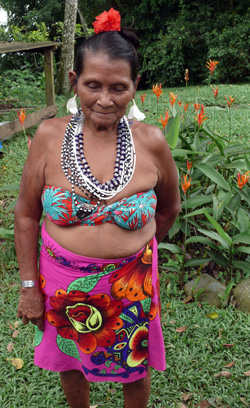
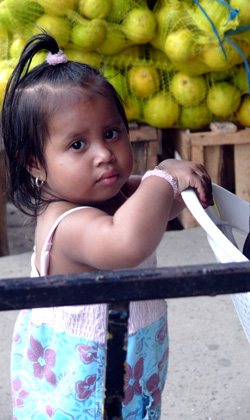
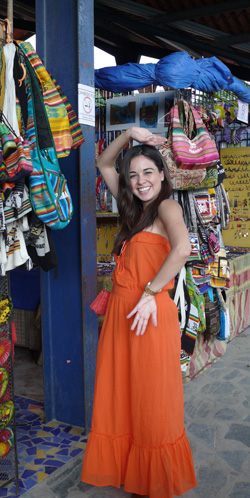
Left: Native Panamanians care for the country’s rain forests. Middle: Panamanians are easy to fall in love with. Right: Lovely Panamanian women like to pose for strangers.
El Valle de Anton, thanks to the soothing hot springs that dominate this lush valley, has become a weekend retreat for affluent Panamanians, but on weekdays it remains a farming community where fruits and vegetables prosper in the rich volcanic soil.
El Valle is also a land of legend; inhabited by Native Americans hundreds of years ago and a place where petroglyphs have been found, but not yet been deciphered.
In recent years, seeing how neighbouring Costa Rica has benefitted from eco-tourism, Panama has been trying to develop its own ecological tours and is using El Valle, where rare plants and animals flourish and waterfall-filled rainforests dominate, as the epicentre.
Hungry from the long journey, our small group enters one of Anton’s many roadside eateries and scans the menu looking for local delicacies.
Listed is “fried this” and “fried that,” prompting one in the group, a charming woman named Cindy, to observe: “Panamanians must live by the credo if it doesn’t move, then fry that sucker!”
While devouring our expertly prepared fried plantains, Sonia-Daniela tells us that after lunch we’ll be visiting El Macho, a 30-metre-high waterfall that is the valley’s biggest tourist attraction.
En route to El Macho, Francisco shares one of the area’s ancient legends about a mountain known as the Sleeping Lady which suddenly appears ahead of us as we turn a corner.
Francisco says the mountain’s name comes from a legend about a chief’s daughter, who was not permitted to marry the Spanish explorer she fell in love with and so vanished into the mountain and was never heard from again.
“Look,” says Sonia-Daniela, “the mountain is actually shaped like a sleeping woman.”
At the entrance to El Macho we are offered a chance to fly high above the beautiful waterfall in a canopy for $35 or walk to it along a well-marked trail for a $3 entrance fee.
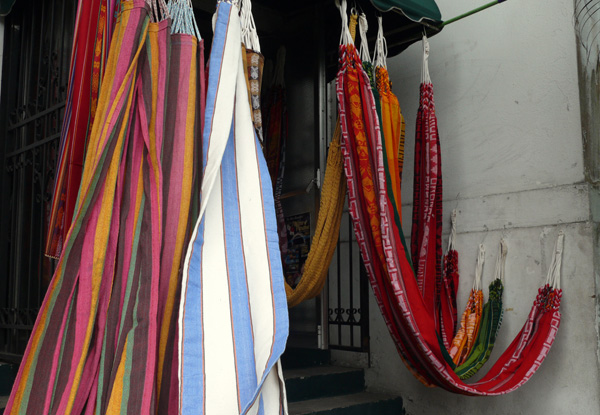
Above: Hammocks play a big role in everyday life in Panama.
We all decide to walk and are rewarded by the sight of beautiful flowers, gently-flowing streams and lush vegetation — lots of Kodak moments here.
We hear El Macho long before we see it and Sonia-Daniela warns us to be on the lookout for “square trees and golden frogs,” two of the rare species found in this national park.
One of the group gasps at the sight of a beautiful orchid which our guide identifies as a “Flower of the Holy Spirit” — Panama’s national flower.
We cross a small wooden bridge and approach El Macho, whose foaming waters stand out brilliantly against an emerald green forest backdrop.
One romantic in the group wonders if the waterfall is really “the tears of the Sleeping Lady.”
The guide says many people explore the park on horseback and in recent years motorcyclists have invaded the area.
Inspired by what we see in El Valle de Anton, we make Sonia-Daniela promise to show us more of Panama’s eco-delights.
Next day, Francisco picks us up early at our Panama City hotel and an hour later we’re in the posh lobby of the Gamboa Rainforest Resort, an ultra-modern facility built on the Rio Chagras (Chagras River), part of the Panama Canal system.
The resort is nestled in a rainforest that was actually saved when the canal was built. Now, the rainforest has become an important contributor to the local economy because of the tourists it draws.
We join other visitors lining up for the 1.2-kilometre-long aerial tram that soars high over the 137 hectare national park and introduces modern-day Tarzans and Janes to the ecological wonders below — rare plants, birds, some of the 16,000 species of butterflies found in Panama, caymans, snakes, toucans “and if you look really closely you may even spot a monkey,” says our aerial tram guide Tomas.
As the tram (it costs $35 to ride) slowly climbs to the top of the rainforest mountain, Tomas tells us the word Panama means “abundance — and this area truly is abundant in so many beautiful things.”
At the top, passengers disembark and scale a 20-metre-high observation tower, from where we get glorious views of giant ships slowly making their way from the Pacific to the Atlantic Ocean through the Panama Canal.
In the distance, we see native villages hugging the shores of the man-made lakes constructed so the canal could be fed with fresh water.
Tomas tells us that the indigenous people are now the guardians of the rainforest. They gave up farming the land when the canal was built in return for being made custodians of the rainforest. Later, we meet some of the village elders who sell handicrafts to the tourists.
Our small group is totally mesmerized by what we’ve seen but as we return to the resort, we voice our disappointment over not seeing a monkey.
Not to worry — Sonia-Daniela has a surprise in store.
“I’ve arranged for a boat to take us to Isla Monos (Monkey Island) where I’m sure we’ll see lots of monkeys,” says the delightful woman with the olive oil skin and the black sparkling eyes.
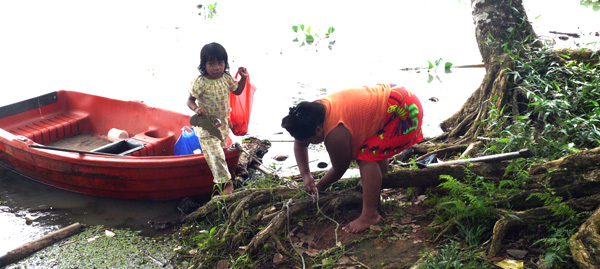
Above: Life along the Panama Canal is challenging.
A speed boat picks us up at the dock opposite the resort’s waterside restaurant, Los Lagartos, where we’re told we’ll return and have lunch. Soon, we’re riding alongside massive cargo ships in the middle of the Panama Canal.
Tomas has come along for the ride and fills us with lots of facts about the canal and the islands that emerged when the man-made marvel was dug out back at the start of the 20th century.
As the boat gets closer to Isla Monos, the young captain cuts the engine and we drift closer to shore.
Suddenly, we’re startled by some high-pitched screeching coming from the dense bush that blankets the island.
“It’s the monkeys warning each other that we are here,” says Tomas, who says the monkeys are irritated by the noise of the outboard engines.
There are five species of monkeys living in Panama and two of them reside on Isla Monos.
With cameras at the ready, we patiently wait for the monkeys to appear. While waiting, we snap pictures of giant turtles swimming in the gentle surf and a large lizard sunbathing on a piece of driftwood.
Tomas asks if anyone aboard has fruit? He takes a ripened banana one of the group has brought along for a snack and breaks it into small pieces.
Then, he places the morsels on the bow and makes monkey sounds hoping to lure some of the island’s residents.
Within seconds, a whole family of white-faced capuchin monkeys appears — the alpha male is the first to jump on the boat and grab a piece of the banana. The female is next and then junior arrives on the scene and dances for his dinner.
The scene is absolutely delightful.
The boat sways from side to side as the passengers jostle for the right camera position. Once the banana has been consumed, the family quickly disappears into the trees and we begin our voyage back to the resort.
Over a delicious lunch on the patio at Los Lagartos, we excitedly talk about our experience in Panama and all agree that this country is the best kept secret in the eco-world.
One of the group boldly says: “Panama is the new Costa Rica.”
“I like the sound of that,” laughs Tomas.